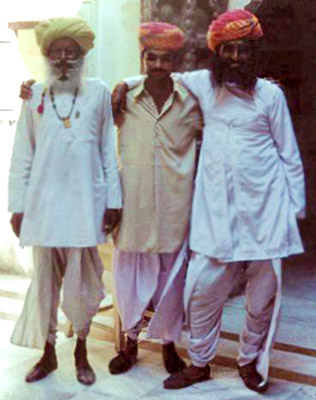 Kurta is the most common upper garment of Rajasthan that is lately adopted as the casual wear for many Indian men. The development of the upper garment, known as the kurta, probably began in the nineteenth century and it is, at present, a popular garment among men of Rajasthan. The length and girth of the kurta may both differ from region to region and it can be customized in a range of styles.
Kurta is the most common upper garment of Rajasthan that is lately adopted as the casual wear for many Indian men. The development of the upper garment, known as the kurta, probably began in the nineteenth century and it is, at present, a popular garment among men of Rajasthan. The length and girth of the kurta may both differ from region to region and it can be customized in a range of styles.
The kalidar kurta is made from several geometrical pieces. It has two rectangular central panels in the back and the front. The width of these panels is almost equal to the shoulder size and the length varies from above the thigh to below the knees. Four, flared-side panels called kali, are attached on either side of the central panels. Their shape is roughly triangular, narrow at the top and wider at the bottom to achieve the desired fullness. This ensures a snug fit around the chest, which lends the lower part a loose-flared fall. Comfort is further emphasized by deep slits at the side seam. The sleeves, which are generally full-length, are also rectangular. They are cut square at the top and the armholes are set somewhat deep. Small triangular gussets are then inserted under the arms and the sleeves taper very slightly towards the wrist. The neck of the kurta is often round; although it may sometimes also have a Chinese collar and most garments have a side pocket. The centre front opening has a placket with buttons and buttonholes as closures. Sometimes, buttonholes are made on both sides of the placket, into which silver or gold buttons are inserted, which are held together by ornamental chains.
Another type of the original kurta has two central panels, back and front, which bulge out at the bottom. The armholes are also shaped and the sleeves are fitted into them with a gusset. A shorter variation of the Rajasthani kurta is the jhulki. Interestingly, both the men and women of the Garasia community in Rajasthan wear it. The men`s jhulki is essentially white in colour. It is a half-sleeved garment that has three buttons on the front. It has a pocket stitched on the left side of the bodice.
More recently, men have also adopted a garment, which is a cross between the classic men`s shirt and the traditional kurta. This pattern has been adopted as casual attire of urban men as well. It has a shirt collar, cuffed sleeves and a kurta placket. It is as long as a kurta and its cut is the same but the hem is shaped with short slits t the side seam.





















